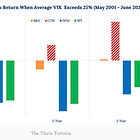Why Neutral Options Strategies Are Difficult To Implement
Our thoughts on the short strangle and iron condor
Hi there,
It’s time for a new research/discussion on/of an options strategy.
Since we started this Substack, we’ve published 5 blogs on data-driven insights for prudent options setups.
These articles perfectly summarize what we’re trying to do (without pretending we’ll be right 100% of the time). The common denominator is that understanding how implied volatility creates opportunity (or flags that we’d better be careful) leads to fairly stable results.
Since the Substack’s inception, the total return including the updated P&L for the one-year setups stands at +6.33%.
Surprisingly, our decision to take on more static delta/positive exposure has led to a total portfolio return of >4% since March 31, just a few days prior to the tariff announcement. The Nasdaq’s up 3.2%, and the S&P’s up 0.8%. All while being much more defensively positioned (and we’re still sticking to this mindset), we’ve been able to capture more upside potential and reducing downside volatility.
Interestingly, over the course of the next 35 days, there’s still about 1.6%-1.7% in positive time value to come our way. If the stock market doesn’t move, we’ll be close to our annual target of 8% - 9% already with 6.5 months to go, including the growing contribution from the 1-year setups.
We’re in the right spot, and let’s keep it that way.
Anyway, let’s get on with today’s discussion on short strangles and iron condors, as they’ve popped up in some e-mails we’ve received from you. We don’t use them, but are these so-called delta-neutral strategies attractive?









